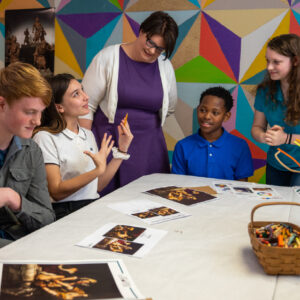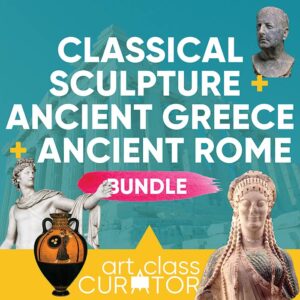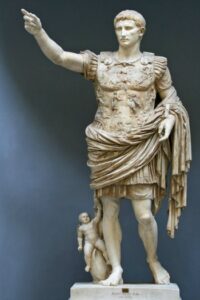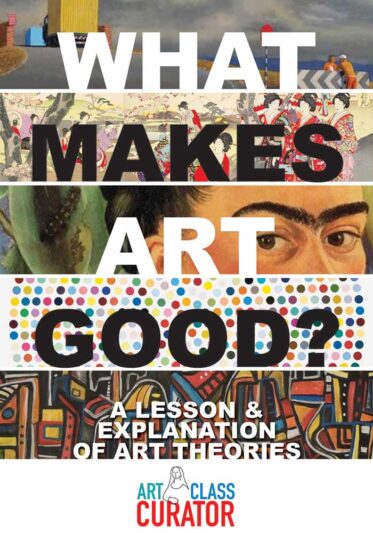Inside: In this Ancient Roman & Ancient Greek sculpture lesson, students learn about art history through an interactive activity.

As a long-time teacher, I have a handful of lessons that I know always work. I can pick up these lessons and give them anytime and know that they will lead to engaged students, thoughtful discussions, and fun learning. Today, I am going to tell you about one of these lessons — an all-time favorite activity that I developed for teaching art history.
But first, indulge me with a little bit of a rant.
A Short Rant about Art History Lesson Plans
Have you ever noticed that in lesson plan after lesson plan for art history, they ALWAYS start with “explain the art history to the students?” Every time, the lesson tells us to teach about the art/artist/art history, and THEN do this activity or art project or whatever. This drives me nuts. We need to take art history out of the dark lecture halls and find fun ways to teach it that don’t involved us standing in front of the room with a PowerPoint.
It has been one of my goals throughout my career to find ways to teach art history that do not start with lecture or reading. I want students to figure it out on their own first. I want them to look and analyze and notice and compare and categorize and think and wonder. I want them to figure out and understand the conventions of the art period or movement before I give them a list of basic characteristics.
Okay, thanks for letting me get this off my chest. Onward.


Get the Full Lesson!
This Lesson is in The Curated Connections Library!
Find the full lesson from this post along with hundreds of other art teaching resources and trainings in the Curated Connections Library. Click here for more information about how to join or enter your email below for a free SPARKworks lesson from the membership!
Classical Sculpture Lesson
Side Note: This is all nudity today, so if that is something you are avoiding for whatever reason, you probably want to skip this lesson. You can’t teach Classical Sculpture without nudes. Here is my post about nudity if you are interested in my thoughts about nudity in art.
Recommended Age: High School and College. I’ve done this with 6th grade as well with a smaller amount of images.
Time Needed: This lesson usually fills a full 1 hour and 20 minute class for me at the community college. You could easily split it into two parts if you have shorter class periods.
Objective
The objective of this lesson is to teach the conventions of the main periods/styles of Ancient Greek and Ancient Roman sculpture: Archaic, Classical, Hellenistic, Roman Imperial Portraits, and Roman Sculptural Realism. Instead of teaching the different periods and pointing out the differences, I like to throw a bunch of pictures at the students, and have them work in groups to figure it out on their own.
Lesson Procedure
In this classical sculpture printable, you will find 20 pictures of sculpture from Ancient Greece and Rome. Here’s what I do. This is written for a full class of students, because that is what I used it for, but you can adapt this as an individual activity for homeschool of course.
1. Before class: Print the images (one set of images per group). See bottom of this post for the link to download the needed files. Cut out the photos (or have the students do it) and put each set in its own envelope.
2. Divide the class into groups of 3-4 and distribute one set of images to each group along with the instructions and worksheet.
3. Instruct the groups to divide the images into 5 groups of 4 images each in whatever groups they want. Tell them they have to come up with the groups and the categories on their own. They have to study each artwork in order to find similarities and differences.
4. Give the students time to complete the activity. Have each group fill out one worksheet that lists which artworks are in each group and why they chose the groups they did (what do the images in the group have in common?).
5. Have the students lay the images on the desks or tables for everyone to see when they are finished. Have all the students stand up and tour the room noticing how each group divided the groups, and then have each group present to class their categories and criteria for the sculpture groups. The students really enjoy seeing how their groups differ from the rest of the class’s groups.
6. Optional: I just came up with this idea right now, but I haven’t tested it. You could at this point pass out a sheet with the correct answers on it, and then have the students compare the correct ones with theirs. This may take too long though as this lesson already takes a good amount of time as is.
7. Review the correct answers with the class using the PowerPoint (download below). Explain the different periods and have students comment on and discuss the similarities that unite the groups together.
8. I usually follow this with a little assessment at the end or at the beginning of the next class period and show some pictures and have the students tell me which period it is from. That is not included in this resource.
When I say this is a “successful lesson,” I don’t mean the students ever get the groups correct. They hardly ever do, but the point of the lesson is not “correctness.” The goal is to get them looking carefully, analyzing, and thinking about art. They are now much more likely to remember these sculptures, because they have thought about them, done something with them, and talked about them. Although they weren’t correct at the beginning, the students do very well at identifying the different styles after the lesson!
Art Downloads for this Lesson
If you are a member of the Curated Connections Library, you can get this lesson and all of my other resources for one monthly or yearly fee. Membership to the Curated Connections Library opens twice per year! Find out more information here and join the waitlist to get first dibs on your membership.
You can also buy this lesson along with units on Ancient Greece and Rome at the below link.

Classical Sculpture, Ancient Greek, & Ancient Rome Lesson Bundle
In these lessons, students will learn about the art of Ancient Greece & Ancient Rome. Plus, get a complete Classical Sculpture lesson with an interactive activity to empower students to figure out the conventions on their own!

Try it out, and let me know how it goes! What is your favorite activity to teach art history without lecture?
Mentioned on the Art Class Curator Podcast…
This post was originally published on January 19, 2015.






Hi,
I have just discovered your site and was interested in your comments on how to get by the nude art situation.
I am not a teacher but facilitate children’s art & craft workshops during school holidays for our local council, so do a bit of web surfing for inspiration.
I am also a grandmother of small boys one of which loves art.
I would just like to share with you a story regarding nude art when I was sitting them over night.
I have a nude pastel drawing in my bedroom which was done by my cousin in art class.
The following morning after the sleep over the youngest one about 6 at the time ran into my room and hopped into my bed and a bit later the 8 yr old “artist” joined us.
The 6 yr old started to be silly looking at the drawing and I asked why he was being so silly and and he said that’s rude…it must have been the first time he had noticed it.
8 yr old said to him in a very mature way “that picture is not rude Sebastian that is art…it’s real art our cousin did that and she is a real artist”
I was so taken aback by the fact that at 8 he could tell the difference between art and rude.
I had taken Mr 8 to the state gallery 2 yrs earlier and he had seen some nude art then and I had made that comment matter of factually to him when he was a bit embarrassed and I was so pleased that it had stayed with him.
So I guess it is how you tell children that counts and if you aren’t phased about it they won’t be either. I hope you have the same results when you need to deal with the subject
Regards
Shirley Jenkins
Sydney, Australia
Yes! I love it! I do the same thing. I talk about it very matter-of-factly with students and don’t address any silliness from them. I simply explain it and why artists do it and move on. I totally agree that it really is the way you talk about it. That’s so great that your grandson remembered and taught his younger brother. I plan on writing a post about this, but I haven’t yet. Would you mind if I quoted your comment in the post?? Thank you so much for sharing! 🙂
I would love to hear your response to your studens re: nudes in art. If you have time, would you be kind enough to share what you say? I agree that the matterof fact approach is best.
I very much enjoyed your presentation at the AOE conference.
Thank you! I have a whole post I want to write about this, and I think now is the time. I’ll let you know on here when I get it up.